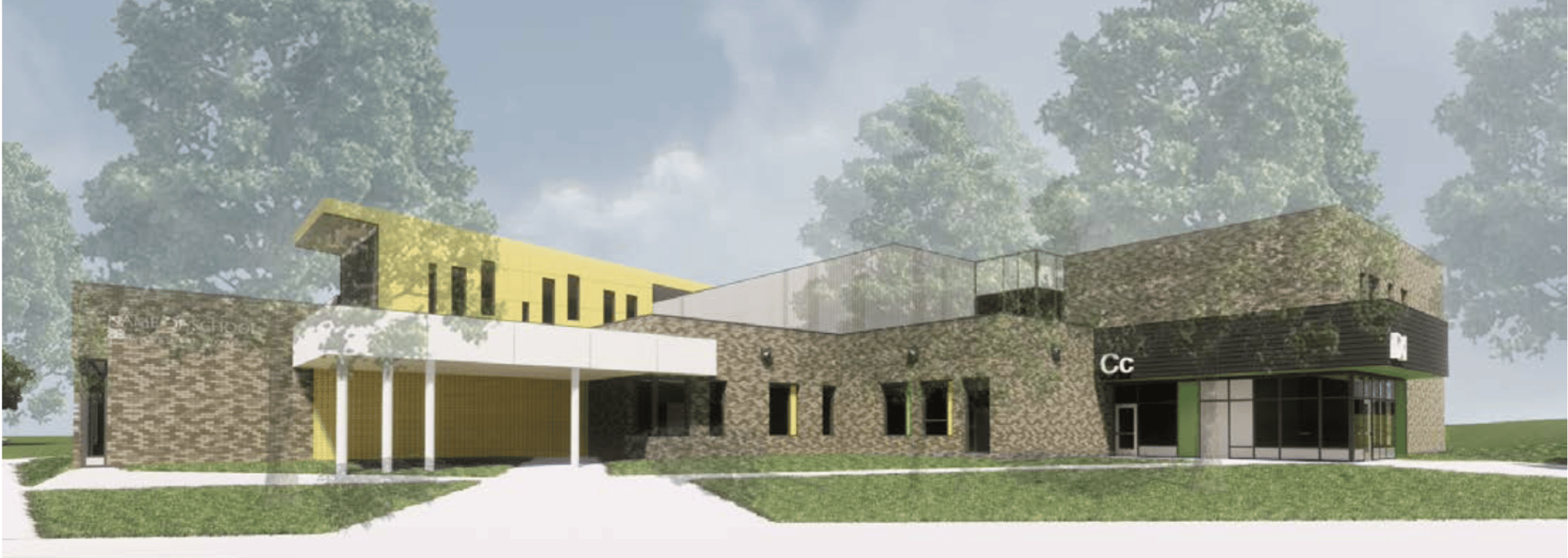Incorporating 21st-century learning into the design of two Edmonton-based schools was the main object of this IPD project in Canada. As the owner, the Edmonton Public School Board requested to develop a program and floor plan for the Thelma Chalifoux School and Soraya Hafez School (TCSH) that utilized the areas allocated by the provincial grant agreement to reflect a modern education approach. They decided in favour of the collaborative IPD approach because there were few precedents to help guide this process with traditional delivery methods.
The Thelma Chalifoux School project needed to accommodate 900 new junior high students while the Soraya Hafez School aimed at a capacity of 650 students.
The two projects were grouped into a single IPD project and one team with two separate IPD contracts.
Investigating Factors Leading to IPD Project Success in Canada is a new research report including three IPD case studies. It was co-authored by Ahmad Arar, M.Sc., PhD Candidate, and Prof. Erik Poirier, PhD, from the Ecole de Technologie Supérieure, Montreal, Canada. Further members of the research team included Prof. Sheryl Staub-French, PhD, Adjunct Prof. Puyan Zadeh, PhD, and PhD Candidate Devarsh Bhonde, MTech.
Project at a Glance
Building Type: Education
Project Type: New construction
Location: Edmonton, Alberta
Building Size: 88,640 sqft and 58,910 sqft
Budget: $27,057,901 and $18,151,753
Schedule: 6 months Design, 32 months construction
Owner: Edmonton Public School Board
Architect: ACI Architects and Number TEN
Contractor: Delnor
Project Start: November 2017
Completion: February 2020

Soraya-Hafez-School
THE CHALLENGES
The owner of this project is a public-school board. Their projects are inherently community-based and held to a strict timeframe because they need to be ready for students and personnel on a specific date. In the past, their projects frequently encountered roadblocks and delays, putting the project delivery team under constant stress. According to the owner who personally managed five past projects, they were extremely stressful and over budget. Two of them were delayed and delivered four months late.
Furthermore, the owner expressed their dissatisfaction with the traditional process in general, citing a significant number of change orders they had to deal with on every project, as well as conflicts coming from adversarial relationships that affected their projects.
Developing the contract
A Hanson Bridgett IPD agreement was utilized for the contract. The owner's biggest issue regarding the contract was obtaining the funding agent's approval. Due to a misunderstanding of IPD and major concerns about liability, the no-litigation provision had to be removed, and many team members saw this as counter to the spirit of IPD. Basically, allowing for lawsuits in IPD is like enabling one to sue oneself, because the teams are all bound by the same contract, making the failures of any member their responsibility.
Goal Setting
The goal-setting process for the TCSH project began early in the big room. The owner wanted all team members included in the process and that all the principles were presented in the project values definition workshop.
The team set two types of goals:
- Hard goals with measurable targets, such as
- Meeting deadlines
- Maintaining on budget
- Achieving a LEED® Silver Certification rating at a minimum.
Additionally, the conditions of satisfaction outlined the project values and were related to the design parameters of the two schools, such as belonging, collaboration, community, and comfort.
2. Soft goals, such as
- Team values
- Behavior.
Furthermore, the team explained that the Wishlist items served as a target for them and that they intended to reach their objectives and more. The owner also wanted to be able to return funds to the funding agent as a stand-alone aim to demonstrate the benefits of IPD.
Team selection
Prior to this project, TCSH had completed one earlier IPD pilot project. They used a batch group recruiting strategy in their pilot project, and based on that experience, they chose not to reuse that technique. They felt that they missed out on an opportunity by not being part of the team selection process, which they realized was a critical process in which the owner should participate.
The alternative was the waterfall strategy, in which the key players, such as the general contractor and the architect, were hired first, while the other players, such as the engineering companies and specialized trades, were hired afterwards, in a cascading manner.
Decision structure
According to the team members, the decisions were very collaborative in the TCSH. The project made decisions based on project values that everyone understood and agreed on. They acknowledged that IPD had the advantage that many experienced people can participate in the decision process, which increases its chances of being the right decision for the project instead of leaving that responsibility to only a few participants.
Although managing the decision-making process with such many people was difficult at first, the project soon benefited from the team culture that had been established and the process was kept efficient and productive.
Onboarding
While some of the team had prior IPD experience, it was for many, including the general contractor, their first IPD project. As a result, much of the onboarding process was devoted to explaining the key ideas and terminology associated with IPD.

Thelma-Chalifoux-School
THE SOLUTION
The project characteristics and prior unsatisfactory experiences with traditional project delivery systems were key considerations that led to choosing an IPD approach.
External IPD facilitator
For the TCSH project, IPD facilitation was handled by a specialized consultant, who joined the team as a member of the multi-party contract and as part of the risk-reward pool. As such, the facilitator participated in all the project phases, unlike the other two cases where the facilitator was available at the validation phase only or intermittently. Additionally, the facilitator's role ensured proper communication of the project goals and values to everyone outside the big room. It is worth noting that this was a more formal process led by the facilitator, involving a unique program used to inform the site supervisors about what was discussed in the big room, as well as constant outreach to field personnel and presentations of project concepts and goals.
Collaborative environment including all stakeholders
A project to build two schools is not a typology that would normally strongly motivate one to choose an IPD approach. Indeed, the schools had to be delivered to meet the Alberta Education/Alberta Infrastructure School Capital Manual. However, what makes this project different is the owner's plan to incorporate 21st-century learning principles into the school's design, which is a relatively new concept with few precedents to help guide the process.
The IPD approach provided a collaborative environment and early participation of all stakeholders, which was an ideal process for working through how to apply this new concept in the design phase. "I think TCSH would have struggled to get the 21st-century and to get these schools built if it would not have been an IPD delivery method."
Moreover, the team communicated and explained the project goals, including the 21st-century learning concept, to the entire team on-site through stand-up meetings, which was appreciated by the team. One said, "I think they actually appreciated, you know, us taking the time to set that up for them and walk them through that because they are the ones building it and making our dreams come to life."
Owner as project champion
All of the team members we interviewed saw the owner of the TCSH project as the project's champion for IPD, and they characterized the owner’s contribution as critical to the project's success. "We can all talk about the contractors and the consultants and everybody working together, but the owner is a really key piece of this."
Championing IPD by the owner was featured in a few aspects. First and foremost, the owner thoroughly comprehended the IPD process and backed up the team throughout the project, in addition to their role in maintaining the team culture and spirit.
Big room and and team culture
In the first days of the big room, when all the team members had been hired, a quick and intensive onboarding activity took place. The process was guided by the facilitator, and it was focused on improving IPD knowledge, tool training, identifying project values, and team culture building.
To build trust and respect among the team, they participated in a variety of social activities. Some took place in the big room, like icebreakers, others, on the construction site, included all the workers, for example sharing a meal to celebrate a milestone achievement, while others took place off-site such as sporting activities to help the team build their relationship and establish the desired culture within the team.
IPD enables lean concepts
The TCSH project team believed that IPD assisted in breaking down some of the barriers that typically exist in traditional projects and enabled the project to apply Lean concepts. Most of the lean scenarios centred on the use of pull planning and implementing waste-reduction measures that benefited from the IPD environment. "It breaks down some of those barriers around equipment, sharing of resources, sharing of deciding who is in the best position to do the scope of work."
Lean thinking, as reported by the team, was reflected in the way they looked at every small decision in the project, making sure it was the most efficient and could reduce waste:
- What is the optimum location for the site restrooms?
- What is the ideal location for garbage cans?
- How can we reduce the distance that workers on the job site must travel between their materials and their work area?
As a result, the team identified the IPD impact as an enabler and facilitator of Lean principles and techniques.
Colocation
In the TCSH project, colocation took place one full day per week at first, then half a day per week as the intensity lessened in the late stages of the design phase. The time spent in the big room was characterized as a problem-solving session, with the presence of all team members given a chance to obtain and provide meaningful input in a short period of time.
According to the team, this frequently resulted in an immediate PIT (Project Implementation Team) meeting arranged by the affected parties to discuss an issue. "You could mention something, and then next thing you know, you would have an informal PIT, happening immediately with the experts in the room." Furthermore, the project benefited from having the full team around the table, which allowed for a quick decision-making process that could generally be completed in the same meeting. Consequently, the project workflow was improved and accelerated, as one described it, "That streamlines workflow, and it also empowers people, I think, much more than a traditional project."
The Project team
- Owner: Edmonton Public School Board
- Architect: ACI Architects Inc.
- Specialty Architect: Number TEN Architectural Group
- IPD Facilitator: EcoAmmo Sustainable Consulting
- Structural Engineer: Read Jones Christofferson Ltd.
- Mechanical Engineer: Arrow Engineering Inc.
- Electrical Engineer: SMP Engineering
- General Contractor: Delnor Construction Ltd.
- Mechanical Contractor: ICON Industrial Contractors Ltd.
- Electrical Contractor: Altapro Electric Ltd.
- Steel Trade: Collins Industries Ltd.
- Drywall, Steel Stud, and Painting: Ideal Contract Services Ltd.
- Sprinkler Trade: Streamline Fire Protection Ltd.
RESULTS
Many of the team members interviewed stated that the TCSH project was the most collaborative project they had ever participated in, benefiting from the trust and open communication that removed the barriers between the team.
The IPD projects' collective management approach has a direct influence on the team's feeling of accountability.
The team's capacity to fulfill their jobs more efficiently was directly influenced by the collaboration enabled amongst them. The opportunity to work together with all the teams was highly valued, and it was seen as critical to the project's success.
The team members of the TCSH project expressed their satisfaction with the fiscal outcomes of the project. They reported that 100% of their ICL was achieved, all the owner Wishlist items were granted, in addition to achieving some savings on the risk register.
The TCSH project's owner was delighted with the project results. They thought IPD assisted them in meeting their goal by providing schools aligned with 21st-century learning, adding greater value to the two schools by including many of the Wishlist items, and by allowing TCSH to return money to the funding agent. The project's early completion helped to avoid the stress that normally comes with a school opening.
KEY TAKEAWAYS
- The owner concluded that the collaborative environment and early engagement of all stakeholders offered by IPD would be beneficial in the plan to incorporate 21st-century learning concepts into the design of the school.
- To secure official permission, the project was required to eliminate the liability waiver provision.
- The project ensured that the whole team participated in the goal-setting process, which helped them better understand the owner's needs and expectations.
- A hybrid waterfall RFP strategy was utilized. They combined the general contractor with the architect, the electrical engineer with the electrical contractor, and the mechanical engineer with the mechanical contractor.
- The owner understood the IPD process and supported the team throughout the project.
- The owner demonstrated success and faith in the team's abilities, which the team valued highly.
- The team found the decision metrics tool very useful in keeping track of why certain decisions were taken in the project for future reference.
- The facilitation roles in TCSH were assigned to a specialized consultant who joined the team as a signatory of the multi-party contract.
- The project used a structured procedure led by the facilitator to inform site supervisors about what was discussed in the big room and continuous outreach to field staff and presentations of project concepts and goals.
- The owner concluded that Pull Planning would be valuable for all their projects, whether they used IPD. They called it one of the IPD project's major successes.
- The team recognized the IPD effect as an enabler and facilitator of Lean concepts and tools, and it helped break through some of the traditional project hurdles.
- To reduce the costs associated with the big room, two different approaches were used: expanding the number of PIT meetings instead of having longer big room meetings and allowing the team to work on other activities unrelated to the project while in the big room and only report the hours linked to the project.
- Many team members interviewed stated that the TCSH project was the most collaborative they had ever been a part of, owing to the trust and open communication that helped break down barriers.
- Completed on budget
- Achieved savings in the risk register and granted some items on the Wishlist.
- 100% of the ICL was achieved.
For a detailed insight into this new research, download the full report Investigating Factors Leading to Project Success in Canada.
Feature image: Green Chameleon via Unsplash
Related Articles
New Research Testifies IPD Project Success in Canada
New IPD Case Study in Canada
Collaboration, Communication, and Culture Create Succes for the Canada Games Aquatic Center
Erik is a professor in the Department of Construction Engineering at the École de Technologie Supérieure and co-director of the Groupe de recherche en intégration en développement durable en environnement bâti (GRIDD). He specializes in the integration and optimization of information flows within value chains in the built asset industry. Erik serves as Vice-Chair of the Quebec BIM Group, is a member of the Board of Directors of buildingSMART Canada and is the Mirror Committee Director of the Standards Council of Canada for ISO Technical Committee 59 - Technical Committee 13 (ISO TC59-SC13). He holds a Ph.D. and M.Sc. in Construction Engineering from École de Technologie Supérieure and a B.Sc. in Architecture from Université Laval. He also completed a postdoctoral fellowship at the University of British Columbia.




